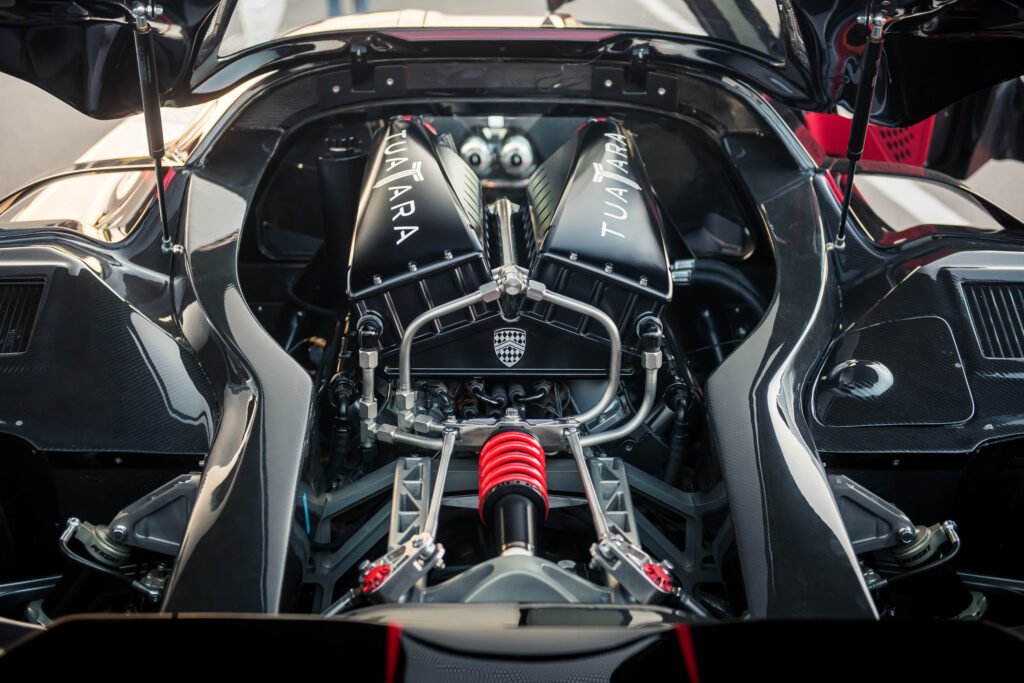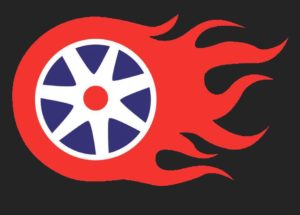SSC North America, America’s first hypercar company, has reclaimed the coveted title of world’s “Fastest Production Vehicle,” this time with its 1,750hp Tuatara.
With internationally acclaimed professional racing driver, Oliver Webb, at the Tuatara’s wheel, the record-breaking drive took place on the morning of Saturday, October 10, outside of Las Vegas near Pahrump, Nevada along a seven-mile stretch of State Route 160.
 Webb pushed the SSC Tuatara to an average speed of 316.11 mph (508.73 km/h) following two consecutive high-speed test runs of 301.07 mph (484.53 km/h) and 331.15 mph (532.93 km/h). In accordance with record criteria, the Tuatara traveled in opposite directions, clocking its speeds within one hour, to break the world record for “Fastest Production Vehicle.”
Officials were on site to verify all world record criteria was met — including review of Dewetron GPS measurements, which tracked the speed runs using an average of 15 satellites — and to confirm the new record.
“It’s been ten years since we held this record with our first car, the Ultimate Aero, and the Tuatara is leagues ahead. Its performance reflects the dedication and focus with which we pursued this achievement,” said Jerod Shelby, CEO of SSC. “We came pretty close to meeting the theoretical numbers, which is astonishing to do in a real world setting on a public road. America’s new claim to victory in the ‘land-based space race’ is going to be tough to beat.”
“There was definitely more in there. And with better conditions, I know we could have gone faster,” said Oliver Webb, who piloted the record run. “As I approached 331 mph, the Tuatara climbed almost 20 mph within the last five seconds. It was still pulling well. As I told Jerod, the car wasn’t running out of steam yet. The crosswinds are all that prevented us from realizing the car’s limit.”
In addition to the “Fastest Production Vehicle” record, the SSC Tuatara broke the world records for:
Webb pushed the SSC Tuatara to an average speed of 316.11 mph (508.73 km/h) following two consecutive high-speed test runs of 301.07 mph (484.53 km/h) and 331.15 mph (532.93 km/h). In accordance with record criteria, the Tuatara traveled in opposite directions, clocking its speeds within one hour, to break the world record for “Fastest Production Vehicle.”
Officials were on site to verify all world record criteria was met — including review of Dewetron GPS measurements, which tracked the speed runs using an average of 15 satellites — and to confirm the new record.
“It’s been ten years since we held this record with our first car, the Ultimate Aero, and the Tuatara is leagues ahead. Its performance reflects the dedication and focus with which we pursued this achievement,” said Jerod Shelby, CEO of SSC. “We came pretty close to meeting the theoretical numbers, which is astonishing to do in a real world setting on a public road. America’s new claim to victory in the ‘land-based space race’ is going to be tough to beat.”
“There was definitely more in there. And with better conditions, I know we could have gone faster,” said Oliver Webb, who piloted the record run. “As I approached 331 mph, the Tuatara climbed almost 20 mph within the last five seconds. It was still pulling well. As I told Jerod, the car wasn’t running out of steam yet. The crosswinds are all that prevented us from realizing the car’s limit.”
In addition to the “Fastest Production Vehicle” record, the SSC Tuatara broke the world records for:
 Tuatara achieved its dominant speeds thanks to a host of features working in harmony, including:
Tuatara achieved its dominant speeds thanks to a host of features working in harmony, including:
 An Automotive Legacy
The SSC team has worked tirelessly to prove one point: nothing is impossible if you believe in yourself and your dreams. Once again, a team of American innovators has given inspiration to those who seek to move the bar higher. SSC enjoys competition and mutual respect between other automakers, and the opportunity to innovate and push the needle in the common pursuit of performance.
Shelby shares his feelings on the culmination of passion, engineering, and intuitive thinking on the day of the speed run by saying, “We validate our engineering by building a car capable of going 330 mph. We validate our passion by accomplishing this, despite years of setbacks and challenges. And we validate our values by making sure Oliver’s safety was the first and foremost important goal of the day.”
“We see ourselves as a piece of history that we hope inspires others to break their own boundaries,” says Shelby. “The only way we got to where we are today is by breaking our own. Accomplishing a feat of engineering that pushes the limits of a road-legal car by a margin this large is both exciting and inconceivable, even to me. We are entering a time where we are no longer faced by the limit of machines, but by the human factor.” The Tuatara is a testament to this.
An Automotive Legacy
The SSC team has worked tirelessly to prove one point: nothing is impossible if you believe in yourself and your dreams. Once again, a team of American innovators has given inspiration to those who seek to move the bar higher. SSC enjoys competition and mutual respect between other automakers, and the opportunity to innovate and push the needle in the common pursuit of performance.
Shelby shares his feelings on the culmination of passion, engineering, and intuitive thinking on the day of the speed run by saying, “We validate our engineering by building a car capable of going 330 mph. We validate our passion by accomplishing this, despite years of setbacks and challenges. And we validate our values by making sure Oliver’s safety was the first and foremost important goal of the day.”
“We see ourselves as a piece of history that we hope inspires others to break their own boundaries,” says Shelby. “The only way we got to where we are today is by breaking our own. Accomplishing a feat of engineering that pushes the limits of a road-legal car by a margin this large is both exciting and inconceivable, even to me. We are entering a time where we are no longer faced by the limit of machines, but by the human factor.” The Tuatara is a testament to this.
 Webb pushed the SSC Tuatara to an average speed of 316.11 mph (508.73 km/h) following two consecutive high-speed test runs of 301.07 mph (484.53 km/h) and 331.15 mph (532.93 km/h). In accordance with record criteria, the Tuatara traveled in opposite directions, clocking its speeds within one hour, to break the world record for “Fastest Production Vehicle.”
Officials were on site to verify all world record criteria was met — including review of Dewetron GPS measurements, which tracked the speed runs using an average of 15 satellites — and to confirm the new record.
“It’s been ten years since we held this record with our first car, the Ultimate Aero, and the Tuatara is leagues ahead. Its performance reflects the dedication and focus with which we pursued this achievement,” said Jerod Shelby, CEO of SSC. “We came pretty close to meeting the theoretical numbers, which is astonishing to do in a real world setting on a public road. America’s new claim to victory in the ‘land-based space race’ is going to be tough to beat.”
“There was definitely more in there. And with better conditions, I know we could have gone faster,” said Oliver Webb, who piloted the record run. “As I approached 331 mph, the Tuatara climbed almost 20 mph within the last five seconds. It was still pulling well. As I told Jerod, the car wasn’t running out of steam yet. The crosswinds are all that prevented us from realizing the car’s limit.”
In addition to the “Fastest Production Vehicle” record, the SSC Tuatara broke the world records for:
Webb pushed the SSC Tuatara to an average speed of 316.11 mph (508.73 km/h) following two consecutive high-speed test runs of 301.07 mph (484.53 km/h) and 331.15 mph (532.93 km/h). In accordance with record criteria, the Tuatara traveled in opposite directions, clocking its speeds within one hour, to break the world record for “Fastest Production Vehicle.”
Officials were on site to verify all world record criteria was met — including review of Dewetron GPS measurements, which tracked the speed runs using an average of 15 satellites — and to confirm the new record.
“It’s been ten years since we held this record with our first car, the Ultimate Aero, and the Tuatara is leagues ahead. Its performance reflects the dedication and focus with which we pursued this achievement,” said Jerod Shelby, CEO of SSC. “We came pretty close to meeting the theoretical numbers, which is astonishing to do in a real world setting on a public road. America’s new claim to victory in the ‘land-based space race’ is going to be tough to beat.”
“There was definitely more in there. And with better conditions, I know we could have gone faster,” said Oliver Webb, who piloted the record run. “As I approached 331 mph, the Tuatara climbed almost 20 mph within the last five seconds. It was still pulling well. As I told Jerod, the car wasn’t running out of steam yet. The crosswinds are all that prevented us from realizing the car’s limit.”
In addition to the “Fastest Production Vehicle” record, the SSC Tuatara broke the world records for:
- “Fastest Flying Mile on a Public Road” at 313.12 mph (503.92 km/h)
- “Fastest Flying Kilometer on a Public Road” at 321.35 mph (517.16 km/h)
- “Highest Speed Achieved on a Public Road” at 331.15 mph (532.93 km/h)
- Be a production vehicle; it must be identical to the same vehicle a customer might purchase.
- Drive the same route in opposite directions, and average the two speeds. This accounts for winds and road grade that may have favored the vehicle as traveling in only one direction.
- Achieve this feat on a public road; this ensures ‘real world’ driving conditions that a race track or runway might not offer.
- Have its speed tracked by a certified GPS measurement system, and have two world-record sanctioned witnesses on site for verification.
- Run on street tires and non-race fuel.
 Tuatara achieved its dominant speeds thanks to a host of features working in harmony, including:
Tuatara achieved its dominant speeds thanks to a host of features working in harmony, including:
- Peerless Aerodynamics: Designed in partnership with world-renowned designer Jason Castriota of Castriota Design, the Tuatara’s design achieved an all-time production-hypercar best coefficient of drag of 0.279. From 150–330 mph, the car maintained a perfect aerodynamic balance of 37% front and 63% rear, ensuring precision downforce across all four wheels.
- Unprecedented Drivetrain: SSC’s V8 powerplant was developed and built in collaboration with Tom Nelson of Nelson Racing Engines. The bespoke 5.9L twin-turbo, flat-plane crank engine produces 1,750 horsepower while using E85, and 1,350 horsepower on 91 Octane. That power is transferred to a CIMA 7-Speed computerized manual transmission working in unison with a state-of-the-art Automac AMT system that operates the engagement and selection of movement in the gearbox.
- Safety: The Tuatara’s robust carbon-fiber monocoque provides vital safety to the driver, and lightweight enough to ensure peak performance. Crash structures across the car generate superior shock-absorbing protection.
 An Automotive Legacy
The SSC team has worked tirelessly to prove one point: nothing is impossible if you believe in yourself and your dreams. Once again, a team of American innovators has given inspiration to those who seek to move the bar higher. SSC enjoys competition and mutual respect between other automakers, and the opportunity to innovate and push the needle in the common pursuit of performance.
Shelby shares his feelings on the culmination of passion, engineering, and intuitive thinking on the day of the speed run by saying, “We validate our engineering by building a car capable of going 330 mph. We validate our passion by accomplishing this, despite years of setbacks and challenges. And we validate our values by making sure Oliver’s safety was the first and foremost important goal of the day.”
“We see ourselves as a piece of history that we hope inspires others to break their own boundaries,” says Shelby. “The only way we got to where we are today is by breaking our own. Accomplishing a feat of engineering that pushes the limits of a road-legal car by a margin this large is both exciting and inconceivable, even to me. We are entering a time where we are no longer faced by the limit of machines, but by the human factor.” The Tuatara is a testament to this.
An Automotive Legacy
The SSC team has worked tirelessly to prove one point: nothing is impossible if you believe in yourself and your dreams. Once again, a team of American innovators has given inspiration to those who seek to move the bar higher. SSC enjoys competition and mutual respect between other automakers, and the opportunity to innovate and push the needle in the common pursuit of performance.
Shelby shares his feelings on the culmination of passion, engineering, and intuitive thinking on the day of the speed run by saying, “We validate our engineering by building a car capable of going 330 mph. We validate our passion by accomplishing this, despite years of setbacks and challenges. And we validate our values by making sure Oliver’s safety was the first and foremost important goal of the day.”
“We see ourselves as a piece of history that we hope inspires others to break their own boundaries,” says Shelby. “The only way we got to where we are today is by breaking our own. Accomplishing a feat of engineering that pushes the limits of a road-legal car by a margin this large is both exciting and inconceivable, even to me. We are entering a time where we are no longer faced by the limit of machines, but by the human factor.” The Tuatara is a testament to this.


